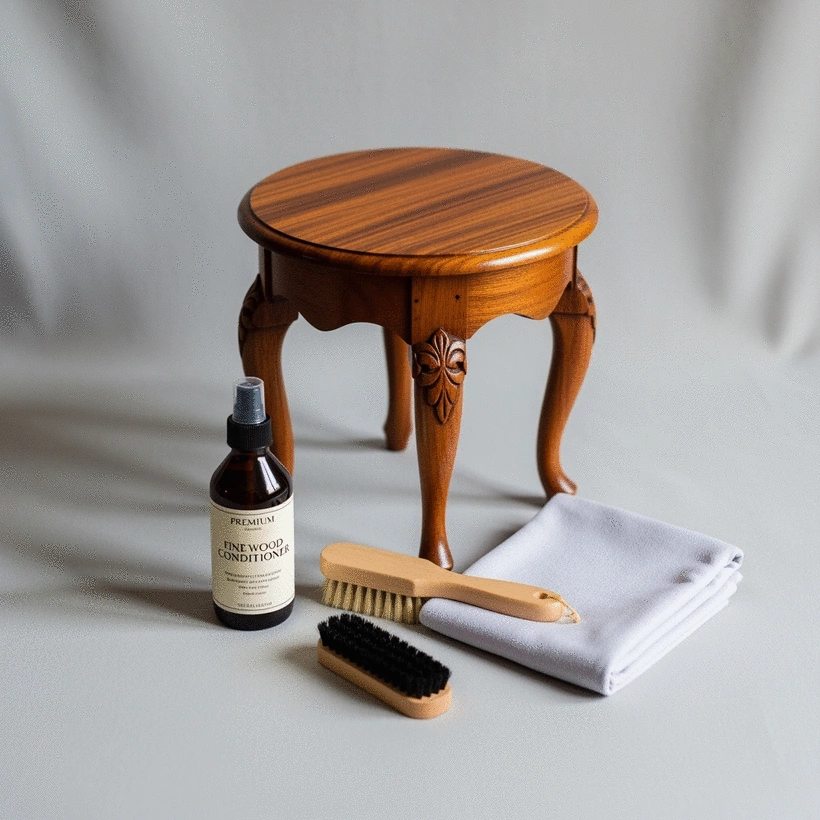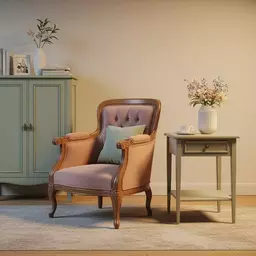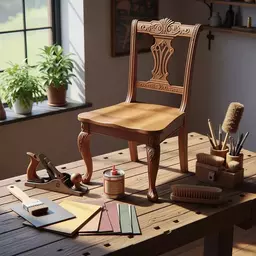Maintaining Antique Wood Finishes

Did you know that properly maintaining antique wood can extend its life by decades? Antique furniture is not just a nostalgic piece of decor; it represents artistry and history. By understanding how to care for these treasures, you can preserve their beauty and significance for future generations.
What You Will Learn
- The importance of identifying the type of finish on your antique wood to select appropriate care methods.
- Regular maintenance prevents damage and enhances the overall aesthetics of antique furniture.
- Establishing a maintenance routine can significantly extend the life of your antique pieces.
- Choosing gentle cleaning agents and natural products helps preserve the integrity of the wood.
- Monitoring environmental conditions, such as humidity, is crucial to prevent warping and cracking.
- Engaging with your antique furniture deepens your appreciation for its craftsmanship and history.
Best Practices for Maintaining Antique Wood Finishes
Here are the key practices to ensure the longevity and beauty of your antique wood furniture. For more comprehensive guides on preserving historical pieces, you might want to explore resources on restoring antique furniture safely.
Prevents Damage
Regular maintenance stops minor issues from becoming major problems.
Enhances Aesthetics
Keeping the surface clean and polished enhances the furniture's overall appearance.
Preserves Value
Well-maintained antiques retain their market value better than neglected pieces.
Regular Cleaning
Dust and clean surfaces with gentle techniques to prevent grime buildup.
Appropriate Cleaning Agents
Choose agents free from harsh chemicals to protect finishes.
Natural Polishing
Use natural oils and waxes to enhance luster and protect surfaces.
Understanding the Importance of Antique Wood Maintenance
Antique wood furniture is not just a piece of history; it’s a testament to craftsmanship that deserves our love and care. Proper maintenance is essential, not only to preserve its beauty but also to ensure its longevity in our homes. As a passionate antique enthusiast, I strive to share the invaluable techniques that keep these magnificent pieces alive for generations to come!
Maintaining antique wood involves understanding the specific needs of different finishes and using gentle techniques that won’t harm the delicate surfaces. With just a little effort, you can keep your treasured pieces looking stunning while also allowing their unique stories to shine through. So, let’s delve into the details of caring for antique wood!
The Value of Antique Wood Finishes
The finish of antique wood furniture is crucial in preserving its character and charm. Different finishes, such as wax, oil, and varnish, not only enhance the natural beauty of the wood but also provide essential protection against environmental factors. By identifying the type of finish on your antique piece, you can select the appropriate care methods to maintain its integrity.
When we choose finishes wisely, we effectively safeguard the rich history and craftsmanship that these items embody. Antique wood finishes can reveal the age, style, and even the geographical origin of the piece, making them invaluable in the world of vintage design. Have you ever noticed how a simple wax finish can bring out the warm hues and grain patterns of wood? It truly feels like magic! For further inspiration on how to integrate these historical pieces into modern settings, consider reading about blending antique furniture with modern decor.
Why Proper Maintenance is Essential
Proper maintenance is vital for antique wood furniture to ensure it stands the test of time. Without regular care, wood can dry out, leading to cracks and damage. Additionally, dirt and grime can accumulate, dulling the finish and diminishing its beauty. Remember, each piece of antique furniture tells a story, and maintaining it means preserving that story for future generations.
- Prevents Damage: Regular maintenance stops minor issues from becoming major problems.
- Enhances Aesthetics: Keeping the surface clean and polished enhances the furniture's overall appearance.
- Preserves Value: Well-maintained antiques retain their market value better than neglected pieces.
As I reflect on my own experiences, I recall how a well-loved Victorian cabinet captured the hearts of my guests, all thanks to consistent care. Imagine the warmth it brings, not just as a piece of furniture, but as a conversation starter, a connection to the past! By embracing proper maintenance, we can ensure that our antique treasures continue to evoke admiration and intrigue.
Quick Summary
Here's a brief recap of the key points discussed so far:
- Antique wood furniture requires regular maintenance to preserve its beauty and longevity.
- Understanding the type of finish on your antique pieces is vital for selecting appropriate care methods.
- Routine maintenance helps prevent damage, enhances aesthetics, and preserves the market value of your antiques.
Summarizing Best Practices for Maintaining Antique Wood Finishes
Maintaining antique wood finishes is not just about keeping your furniture looking beautiful; it's about preserving history and craftsmanship! At the Antique Furniture Guide, we believe that every piece tells a story, and its care reflects our respect for that history. Here are some key takeaways to help you keep your treasured antiques in top condition.
First, establish a routine maintenance schedule. Regular cleaning and conditioning can make a significant difference in your furniture's longevity. Additionally, using the right products ensures that you maintain the authenticity and beauty of the wood. Finally, don’t forget to protect your pieces from environmental stressors that can cause damage over time. Remember, your antique furniture deserves the best care!
Key Takeaways for Antique Furniture Care
When it comes to caring for antique wood, a few fundamental practices stand out. Here’s a quick list to keep in mind:
- Regularly dust and clean surfaces with gentle techniques.
- Choose appropriate cleaning agents that are free from harsh chemicals.
- Use natural oils and waxes for polishing to enhance luster.
- Monitor humidity levels to prevent warping or cracking.
- Conduct periodic inspections for signs of wear or damage.
By following these guidelines, you’ll not only enhance the beauty of your furniture but also deepen your connection to its history. After all, as I often say, maintaining antique wood is like nurturing a relationship—dedication and attention lead to lasting rewards!
The Importance of Routine Maintenance and Attention
Routine maintenance is crucial for preserving the charm of antique furniture. Just like any cherished possession, your antiques require regular love and care. Establishing a routine helps identify potential issues before they escalate into major problems. For instance, a simple dusting can prevent grime buildup that could otherwise harm delicate finishes!
Additionally, paying attention to your furniture allows you to appreciate the craftsmanship that went into each piece. Spend time examining the wood grain, the intricacy of carvings, and the unique stories that every scratch or dent tells. Engaging with your antique wood furniture can bring a greater sense of joy and appreciation for its history! For more insights into preserving these precious items, you might find valuable tips in resources on restoring antique furniture safely.
Engaging with Your Antique Wood Furniture
Encouraging Questions and Feedback from Readers
As we wrap up this discussion on antique wood maintenance, I encourage you to share your thoughts and experiences! What challenges have you faced in caring for your antique pieces? Are there specific tips or tricks that have worked wonders for you? Your feedback is invaluable to us at Antique Furniture Guide as we continue to foster a community of antique enthusiasts.
Feel free to reach out and ask any questions! Whether you're a seasoned collector or just starting on your vintage journey, we’re here to help you navigate the wonderful world of antique furniture.
Inviting Readers to Share Their Experiences and Tips
Your experiences and insights are what make our community special. Have you discovered a particular cleaning method that works best for you? Or perhaps you’ve found a natural product that has transformed how you care for your antique pieces? Sharing these stories can inspire others and create a wealth of knowledge!
At the Antique Furniture Guide, we believe in learning together. So, don’t hold back! Join the conversation, and let’s explore the art of antique care as a community. For those looking to start their journey, a good read on buying vintage furniture in Australia could be a great starting point.
Resources for Further Learning and Exploration
Recommended Reading on Antique Furniture Care
If you're eager to dive deeper into the realm of antique furniture care, there are numerous resources available. Here are some recommended reads that I’ve found particularly helpful:
- The Complete Guide to Antique Furniture Restoration - A comprehensive resource for all levels of restorers.
- Antique Wood Finishes: A Practical Guide - Offers insights specifically on maintaining various wood types.
- Preserving the Past: Techniques for Antique Care - An excellent collection of stories and tips from experienced collectors.
These books not only offer practical advice but also enrich your understanding of the artistry behind antique furniture.
Links to Video Guides and Visual References
Visual learning can be incredibly effective! I encourage you to check out a range of video guides available online that demonstrate various maintenance techniques. Here’s a curated list of channels and playlists worth exploring:
- Antique Restoration Channel - Great tutorials on restoration and maintenance.
- Home Decor DIY - Covers cleaning and care tips for vintage furniture.
- Old World Finishes - Focuses on traditional methods of caring for antique woods.
By utilizing these resources, you’ll enhance your skills and knowledge, ensuring that your antique treasures are cherished for generations to come!
Recap of Key Points
Here is a quick recap of the important points discussed in the article:
- Antique wood furniture requires proper maintenance to preserve its beauty and longevity.
- Understanding the type of finish (wax, oil, varnish) is crucial for selecting appropriate care methods.
- Routine maintenance prevents damage, enhances aesthetics, and preserves the market value of antique pieces.
- Regularly dust and clean with gentle techniques and appropriate cleaning agents to avoid harsh chemicals.
- Monitor humidity levels and conduct periodic inspections to prevent warping or cracking.
Frequently Asked Questions About Antique Wood Maintenance
- Q: Why is it important to identify the finish on antique wood furniture?
- A: Identifying the finish (e.g., wax, oil, varnish) is crucial because different finishes require specific care methods. Using the wrong products or techniques can damage the wood and its historical integrity.
- Q: What are the main benefits of regular maintenance for antique wood?
- A: Regular maintenance prevents minor issues from becoming major problems, enhances the furniture's overall aesthetics by keeping it clean and polished, and helps preserve its market value over time.
- Q: What kind of cleaning agents should I use for antique wood furniture?
- A: Always choose gentle cleaning agents that are free from harsh chemicals. Natural oils and waxes are often recommended for polishing to enhance luster and protect surfaces without causing damage.
- Q: How do environmental conditions affect antique wood, and what can I do about it?
- A: Environmental factors like humidity can cause antique wood to warp, crack, or dry out. Monitoring and maintaining stable humidity levels in your home is crucial to prevent such damage.
- Q: How can I deepen my appreciation for my antique wood furniture?
- A: Engaging with your antique furniture, such as by examining the wood grain, intricate carvings, and unique marks, can deepen your appreciation for its craftsmanship and history. Regular care also fosters a stronger connection to these treasured pieces.







